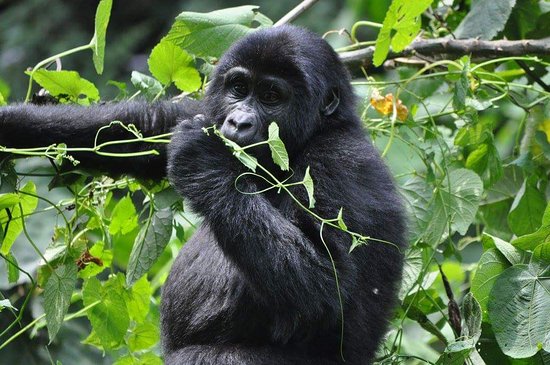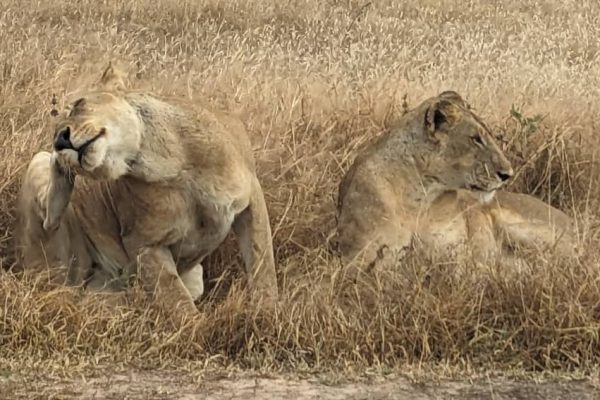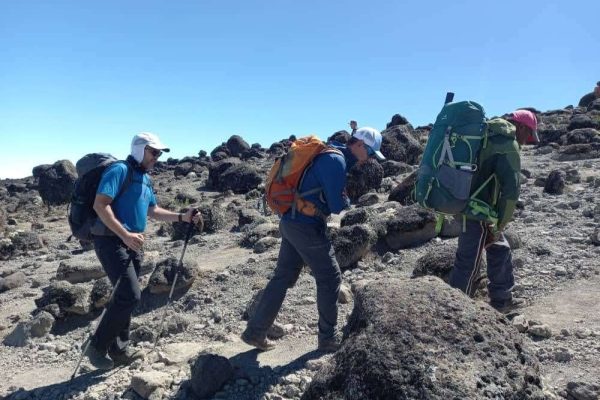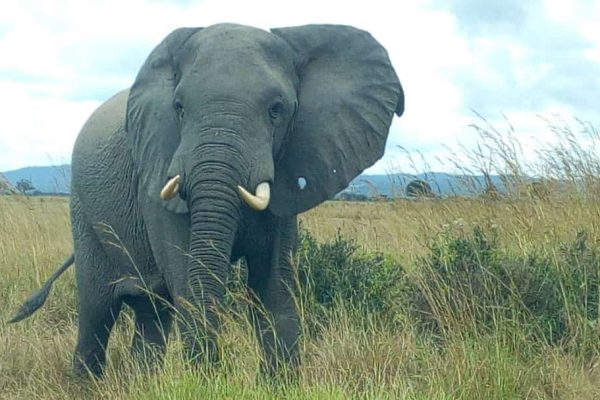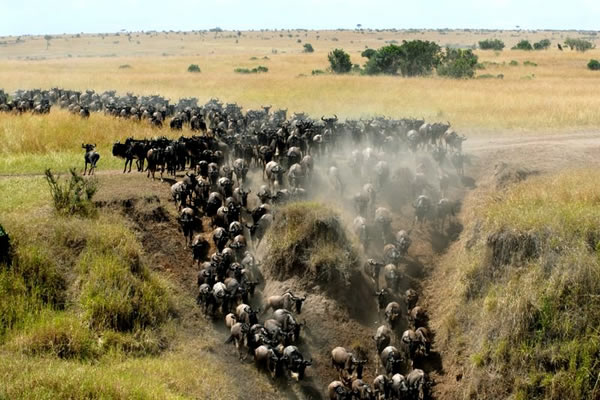14 Days wildlife Gorillas & Rwenzori trekking Safari starts with Gorilla trekking in Bwindi impenetrable national Park, wildlife viewing in Queen Elizabeth National park, then rwenzori trekking adventure in Rwenzori Mountains National Park
Experience the Majesty of the Wild with Nature Nest Safaris
Embark on an unforgettable journey into the heart of nature with Nature Nest Safaris, where every moment is an adventure waiting to unfold. Our Wildlife Viewing Safaris and Wildlife Safaris offer you the chance to immerse yourself in the untamed beauty of the world’s most captivating landscapes and encounter majestic creatures in their natural habitats.
Discover the Thrill of Wildlife Viewing Safaris
Our Wildlife Viewing Safaris take you on a thrilling exploration of some of the most iconic wildlife destinations on the planet. Whether you dream of witnessing the awe-inspiring sight of a lioness and her cubs prowling the African savannah, marveling at the grace of a herd of elephants as they graze peacefully in the golden light of dawn, or observing rare and elusive species in their native habitats, Nature Nest Safaris ensures that every moment of your adventure is filled with wonder and excitement.
Unforgettable Wildlife Safaris Tailored to You
At Nature Nest Safaris, we understand that every traveler is unique, which is why we offer customizable Wildlife Safaris designed to suit your individual preferences and interests. Whether you prefer the thrill of an action-packed game drive, the serenity of a walking safari, or the luxury of a private guided tour, our experienced team will work closely with you to create the perfect itinerary for your ultimate wildlife adventure.
Expert Guides and Unmatched Hospitality
Our team of expert guides are passionate about sharing their knowledge and love for the natural world, ensuring that every moment of your Wildlife Safari is both educational and exhilarating. From tracking elusive predators to identifying rare bird species, our guides are dedicated to providing you with an unforgettable wildlife experience.
Book Your Wildlife Safari Today
Don’t miss your chance to embark on the adventure of a lifetime with Nature Nest Safaris. Contact us today to start planning your Wildlife Viewing Safari or Wildlife Safari, and prepare to be amazed by the breathtaking beauty of the natural world.
Wildlife Viewing Safaris FAQs
What is a wildlife viewing safari and what should I expect?
A wildlife viewing safari is an immersive adventure into natural habitats where visitors observe animals in their native environments. Safaris combine transportation (typically 4×4 vehicles), expert guides, and strategic positioning to facilitate wildlife encounters. You’ll witness animals in authentic behaviors—hunting, grazing, socializing, and raising young—rather than controlled settings. Wildlife safaris range from action-packed game drives spotting predators and herbivores to leisurely nature walks discovering smaller creatures and plants. Experiences include photographing majestic animals, hearing authentic wilderness sounds, and experiencing Africa’s raw natural power. Safaris blend education (guides explain animal behavior, ecology, conservation) with adventure and relaxation. Expectations vary by destination and season—some safaris guarantee Big Five viewing while others prioritize specific species like gorillas or chimpanzees. Every moment delivers wonder as you connect with Earth’s most captivating landscapes and creatures in transformative experiences creating lifetime memories.
What are the best wildlife viewing destinations for African safaris?
East African destinations are premier for wildlife viewing. Tanzania offers the Great Wildebeest Migration (1.5+ million animals), Serengeti National Park (Big Five, predators), Ngorongoro Crater (concentrated wildlife), Lake Manyara (tree-climbing lions, flamingos), Tarangire (elephants, baobabs), and Ruaha (remote wildlife). Kenya features Maasai Mara (migration, big cats), Amboseli (elephants, Kilimanjaro views), Tsavo (red elephants, large predator populations), Lake Nakuru (birds, rhinos), and Laikipia Plateau (conservation areas). Uganda provides mountain gorillas (Bwindi, Mgahinga), chimpanzees (Kibale—1,500 individuals), tree-climbing lions (Queen Elizabeth), Murchison Falls (Nile wildlife), and Kidepo Valley (pristine savanna). Rwanda offers mountain gorillas (Volcanoes National Park), chimpanzees (Nyungwe Forest), and Big Five (Akagera). Each destination specializes in distinct wildlife—savannas support predators while forests host primates. Choose based on preferred species, ecosystem type, and activity level.
What wildlife species can I see on African safaris?
African safaris offer extraordinary wildlife diversity. Big Five include lions (apex predators), leopards (elusive cats), elephants (largest land animals), buffalo (powerful herd animals), and rhinoceros (critically endangered). Additional predators feature cheetahs (fastest hunters), hyenas (adaptable scavengers), wild dogs (efficient pack hunters), and crocodiles (aquatic apex predators). Large herbivores include wildebeests (millions during migrations), zebras, giraffes, hippos, warthogs, and various antelope species. Primates range from mountain gorillas (half-world population in Uganda/Rwanda) to chimpanzees (1,500 in Kibale), golden monkeys, colobus monkeys, baboons, and vervet monkeys. Birds exceed 650-700 species including eagles, vultures, kingfishers, sunbirds, flamingos, and migratory species. Reptiles and amphibians include snakes, chameleons, frogs, and monitor lizards. Smaller mammals feature antelopes, duikers, warthogs, jackals, servals, and hyenas. Safari experiences combine concentrated Big Five encounters with comprehensive ecosystem diversity ensuring continuous wildlife discoveries.
What are the different types of safari activities and experiences?
Game drives in open 4×4 vehicles are classic safari methods providing comfortable wildlife viewing during peak animal activity (early morning, late afternoon). Drivers navigate terrain reaching prime viewing locations while guides identify species and explain behaviors. Walking safaris offer foot-based exploration discovering smaller wildlife, plants, tracks, and intimate nature connection. Armed guides ensure safety while providing detailed ecosystem education. Guided nature walks emphasize forest, wetland, and specialized habitat exploration. Hot air balloon safaris provide aerial dawn perspectives of vast landscapes and wildlife herds from unique vantage points. Boat safaris explore rivers and lakes encountering hippos, crocodiles, aquatic birds, and riverbank wildlife. Night game drives in permitted areas reveal nocturnal species like leopards and hyenas. Photography safaris focus on capturing optimal wildlife imagery with expert positioning and lighting guidance. Walking and climbing combines wildlife viewing with mountain trekking (Rwenzori, Kilimanjaro, Mount Elgon). Cultural experiences integrate community visits with wildlife exploration. Choose activities matching interests, fitness levels, and time availability.
When is the best time for wildlife safaris in East Africa?
Dry seasons (June-October and December-February in most regions) are optimal for wildlife viewing. Animals concentrate around remaining water sources making encounters easier. Trail conditions improve with less mud and improved vehicle access. Vegetation dries enabling better wildlife visibility across open plains. Road accessibility increases significantly. June-October coincides with Tanzania’s Great Wildebeest Migration—the continent’s greatest wildlife spectacle. Wet seasons (March-May and September-November) feature challenging mud and rain but offer advantages: lush landscapes, fewer tourists, exceptional bird watching during breeding and migration, and newborn wildlife. Shoulder months (January, February, September) provide moderate conditions balancing weather and crowds. Year-round visitation is possible with different seasonal highlights. Peak tourism occurs June-October when conditions are most predictable and migration peaks. Choose timing based on preferred wildlife (migration requires specific dates), weather tolerance, budget, and activity interests. Nature Nest Safaris helps determine optimal timing matching your specific goals.
What should I pack and prepare for wildlife safaris?
Essential packing includes sturdy hiking boots (waterproof for wet seasons, broken-in to prevent blisters). Clothing should feature earth-tone colors blending naturally—long-sleeved shirts and trousers protect against insects and vegetation. Layers accommodate temperature variations (warm days, cool evenings, chilly early mornings). Rain gear (lightweight jacket, poncho) handles seasonal rainfall. Sun protection includes sunscreen, hat/cap, and sunglasses for intense African sun. Binoculars enhance wildlife observation from vehicle. Camera with zoom lens and no flash captures memories while respecting animals. Insect repellent prevents mosquito and insect issues. Water bottle (2-3 liters) maintains hydration during game drives. Personal medications including malaria prophylaxis as recommended by healthcare providers. Travel insurance covering medical, cancellation, and emergency evacuation. Comfortable backpack for daily gear. Neutral-colored jacket for vehicle warmth. Gaiters protect legs during walking safaris. Notebooks for wildlife identification. Proper preparation ensures comfort, safety, and optimal safari enjoyment.
How do I choose between different safari destinations?
Choose based on wildlife priorities: gorilla/chimpanzee enthusiasts select Uganda or Rwanda; Big Five seekers choose Serengeti, Amboseli, or Murchison Falls; bird watchers prefer Nyungwe, Lake Nakuru, or Udzungwa; migration spectacle demands July-October Tanzania dates. Activity interests guide selection: adventure seekers choose mountain trekking (Rwenzori, Kilimanjaro), cultural immersion (Maasai villages), or water activities (rafting, Lake Victoria). Budget considerations range from budget accommodations to luxury lodges affecting destination and park choice. Time availability determines whether you do concentrated safaris or multi-park/country combinations. Physical fitness levels suit different terrains—open savannas for comfortable game drives, forests for strenuous primate trekking. Travel companions (families, couples, groups) determine activity and pacing appropriateness. Season preferences (dry conditions vs. wet season birding) inform optimal timing. Accessibility from your origin affects routing and costs. Conservation interests may prioritize specific conservation projects. Nature Nest Safaris travel experts help evaluate preferences against destination characteristics creating perfectly matched safari experiences.
What is the difference between savanah and forest safaris?
Savanna safaris feature open grasslands, scattered acacia trees, and rolling plains. Wildlife viewing is excellent due to visibility across wide areas. Large herbivores (wildebeests, zebras, antelopes) congregate in herds grazing openly. Predators (lions, cheetahs, leopards) hunt across open terrain. Big Five encounters are concentrated. Game drives are comfortable with smooth terrain. Popular destinations include Serengeti, Maasai Mara, Amboseli, and Queen Elizabeth savannas. Trekking involves moderate physical exertion. Photography is straightforward with clear sightlines. Forest safaris feature dense vegetation, towering trees, and specialized habitats. Wildlife viewing requires searching and patience as animals blend into forest environments. Primates (gorillas, chimpanzees, monkeys) inhabit canopies and forest floors. Smaller mammals, birds, and reptiles are abundant. Trekking demands physical fitness and technical skill navigating uneven, muddy terrain. Visibility is limited but encounters feel intimate. Popular destinations include Bwindi, Kibale, Nyungwe, and Udzungwa. Photography is challenging with dappled light and obstructed views. Combination safaris blend both ecosystems—Uganda, Tanzania, and Rwanda offer both savanna and forest experiences creating comprehensive wildlife diversity.
How do wildlife safaris support conservation and local communities?
Safari tourism generates revenue directly supporting conservation efforts. Permit fees (gorilla permits $700-$1,500, national park entries) fund anti-poaching operations, habitat protection, and wildlife monitoring programs. Employment in guiding, hospitality, and lodge services creates economic incentives for conservation over poaching. Community involvement through conservancies and local partnerships ensures tourism benefits reach indigenous populations. Conservation projects receive visitor spending supporting endangered species protection. Education programs funded by tourism teach environmental awareness. Habitat preservation ensures protected ecosystems sustain wildlife populations. Local community development includes infrastructure, healthcare, and education improvements from tourism revenue. Sustainable tourism practices emphasize minimizing environmental impact. Cultural preservation supports indigenous traditions and languages through community-based tourism. By choosing responsible operators like Nature Nest Safaris, visiting during sustainable seasons, and supporting local businesses, visitors directly contribute to wildlife protection and community welfare. Living wildlife generates more income than exploitation, motivating long-term conservation commitment.
What makes Nature Nest Safaris different from other safari operators?
Nature Nest Safaris distinguishes through expert guides passionate about sharing wildlife knowledge and natural world wonders. Customizable itineraries tailor experiences to individual preferences, interests, budgets, and activity levels. Multi-destination expertise enables seamless combinations across Uganda, Rwanda, Tanzania, and Kenya for comprehensive adventures. Conservation commitment emphasizes sustainable tourism practices and community support. Comprehensive destinations access gorilla trekking, chimpanzee tracking, Big Five viewing, mountain climbing, cultural immersion, and specialized activities. Personalized attention ensures individual needs receive careful consideration throughout journeys. Value delivery balances quality experiences with fair pricing. Safety prioritization maintains professional standards and comprehensive preparations. Flexibility adapts itineraries to conditions, wildlife movements, and emerging opportunities. Professional coordination manages all logistics seamlessly from booking through return. Passion for excellence drives continuous improvement in service delivery. From initial consultation through post-safari follow-up, Nature Nest Safaris goes above and beyond creating extraordinary wildlife experiences exceeding traveler expectations.
Can multi-country wildlife safaris combine different ecosystems and species?
Absolutely. Multi-country African safaris maximize ecosystem and species diversity creating comprehensive wildlife experiences. Uganda + Rwanda + Tanzania combination enables mountain gorilla trekking (Bwindi, Volcanoes), chimpanzee tracking (Kibale, Nyungwe), Big Five viewing (Queen Elizabeth, Akagera, Serengeti), and Great Migration witnessing (Tanzania July-October). Kenya + Tanzania combination provides Maasai Mara migration, Amboseli elephants, Serengeti wildlife, and Ngorongoro Crater encounters. Forest + savanna combinations (Uganda/Rwanda forests + Kenya/Tanzania savannas) showcase all major African ecosystems. Mountain trekking + wildlife viewing combines Rwenzori or Kilimanjaro climbing with safari wildlife viewing. Water activities + land safaris integrate Nile rafting, Lake Victoria boat tours, or beach time with traditional game drives. Cultural immersion + wildlife balances nature with community interactions and traditional experiences. Multi-country itineraries maximize primate encounters, wildlife diversity, geological features, and activity variety. They enable savanna predator viewing, forest primate encounters, mountain experiences, and cultural depth in single trips. Nature Nest Safaris designs comprehensive multi-country packages combining your preferred destinations and activities into transformative complete African adventures.



